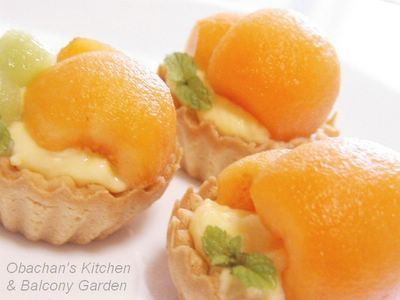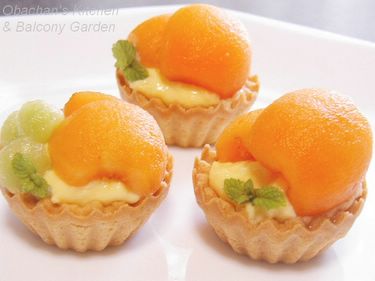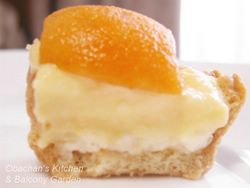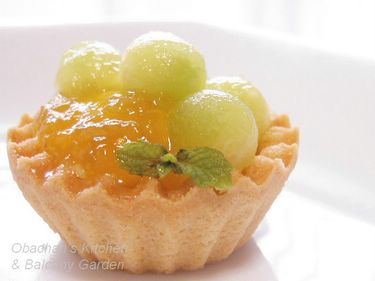
Biwa (Loquat) Tarts
Thanks to a fellow baker who gave me a recipe (in the comment) of perfect pastry cream, I enjoyed a great success with tarts today. This certainly made up for the traumatizing experience I had with the strawberry tart back in May!
 The loquats from my dad’s orchard that I got from mom last Thursday were going bad and needed to be used right away. An inner voice told me that it was a perfect chance to try the pastry cream recipe. And tata-!! The loquats from my dad’s orchard that I got from mom last Thursday were going bad and needed to be used right away. An inner voice told me that it was a perfect chance to try the pastry cream recipe. And tata-!!
Don’t they look nice? They tasted nice, too!
Read More

Another Look (I want something else than mint leaves to garnish my sweets...)
I have a confession to make… I couldn’t find half-and-half, so I mixed whipping cream and milk to make a substitute. For the rest, I generally followed her recipe, except that I used a little less amount of salted butter and omitted the pinch of salt in the recipe. And you are right, a fellow baker, this is a very good, versatile pastry cream!
 The only problem was that very ripe loquats are just so sweet, and with this sweet pastry cream, it was just uninterestingly plain sweet. I needed a twist with something a little sour. You know what I did? I still had some konatsu bavarois left in the fridge and I put a little amount of it at the bottom of the tart shell. (BTW, the tart shells were from the store. I was lazy.) I piled up the pastry cream on the konatsu bavarois and put loquat halves on top. The loquats were peeled, seeded and cut in half, then dipped in marsala wine briefly. Yes, another twist. And those twists worked just fine!! The slightly sour Konatsu bavarois, the sweet pastry cream and fresh loquat made a perfect combination with a crispy tart shell. It was oh so heavenly!! The only problem was that very ripe loquats are just so sweet, and with this sweet pastry cream, it was just uninterestingly plain sweet. I needed a twist with something a little sour. You know what I did? I still had some konatsu bavarois left in the fridge and I put a little amount of it at the bottom of the tart shell. (BTW, the tart shells were from the store. I was lazy.) I piled up the pastry cream on the konatsu bavarois and put loquat halves on top. The loquats were peeled, seeded and cut in half, then dipped in marsala wine briefly. Yes, another twist. And those twists worked just fine!! The slightly sour Konatsu bavarois, the sweet pastry cream and fresh loquat made a perfect combination with a crispy tart shell. It was oh so heavenly!!

Ume (Japanese plum) Jam & Melon Tart
I experimented another combination: the pastry cream, melon, and ume jam that I made the other day! At first I thought the ume jam had a little harshness left, but maybe it was because I tasted it while it was still warm. On the next day, I noticed no harshness at all and I’ve been enjoying the ume jam with yogurt almost every morning. The jam also went well with this pastry cream! BINGO!
You know what I really want to try this ume jam with next?
Crab Rangoon. I always thought that apricot sauce was a bit too sweet to eat with crab rangoon, but this Ume jam would be perfect for me. I have some other ideas for the use of ume jam. Hmmm…maybe I’ll need to make another batch pretty soon.
BTW, It's so difficult to eat a tart with piled up cream and fruits in a cookie-type tart shell gracefully, isn't it?
---
There's a question that I have always wanted to ask people in other countries (except US, UK, Canada and Australia, because for them I already know the answer.) The question is, "How many milliliter(cc)s are in 1cup in your country?" Through the conversions I had to do for foreign recipes in the past, I learned there were differences among countries. In Japan, 1C=200ml. I'm curious about how it is in other countries (except those countries listed above.) Can you help me with this small personal research?
*I made those tarts yesterday after coming back from the Sunday Market, but posted this entry today.
|
![]()

![]()
14 comments:
Obachan the tart looks so good I am licking the screen! ^.^;
One cup in the US is roughly 240ml becuase 1 oz is 30ml (liquid) and 1 cup is 8oz
Posted by vegimouse
obachan;
Your tarts look so wonderful.A pretty garnish could be a swirl of a piece of lemon or lime rind..????
(maybe , candied?) Or maybe an edible flower?
I think the mint is perfect, though...
Your photographs are again so "magazine-perfect"......
Posted by carlyn
In Finland, we only use the metric system, ie no cups. Usually, we use dl (decilitre) = 10 cl = 100 ml for volume measurements. In baking this means that a recipe can call for "5 dl water / 13 dl flour". Sometimes, the amount of flour is in (kilo)grams instead of deciliters, but as most people have a one deciliter measuring cup at home, it is easier to use dl (if you don't own a kitchen scale, measuring weight in grams can be really quite difficult).
See for example: Recipe for pancakes or sweet buns (Virtual Finland)
Posted by paola
Yum yum....love the ume jam and melon tart :)!!!
Posted by emotionalistic
obachan
your loquat tarts look so delicious!! I wish we have some loquat here.
Taiwan's measuring system is the same to Japan. 1C = 200ml(cc)
Posted by pinkcocoa
Yummy.. !! obachan..!! i'm so thrilled by this creation of yours.. :)
Posted by MrsT
> vegimouse --- Hi! Thanks so much for your response! “Licking the screen” is one of the best compliments I’ve had. :D
Yeah, 240ml in the US, 250ml in Canada, Australia, New Zealand and United Kingdom (and maybe France, too?) It’s interesting to find the variety of ways. I'm excited!
> carlyn --- Mmm…lemon or lime rind! I never thought about it but yeah, it's a good idea. Thanks!
(Or I could steal a couple of chervil leaves from the izaka… Ahem ahem! )
> paola --- Welcome and thanks so much for your info.! :D At first using “dl” for measuring flour sounded strange to me, but it does make sense if most people have a 1 dl measuring cup at tome. Interesting! BTW, all the recipes on the site you linked to look so delicious! I must try at least one of them sometime.
> emotionalistic --- Thanks. I think I turned into a big tart-lover this year ;)
> pinkcocoa --- Oh, thank you! So Japan is not the only country that uses "1C=200ml." I wonder about other Asian countries…
> MrsT --- Thanks. This Ume Jam & Melon Tart photo is my favorite! Good job, my camera (and the photo-retouch software)!
Posted by obachan
Dear Obachan,
I've been checking your site to see whether you had made the pastry cream. I'm so glad to see that you did and that it was a success. It's easy, isn't it? Your substitution is just fine. This is why I indicated in the recipe that half-and-half is a mixture of cream and milk. I thought you might not find it in Japan. I recommend that you add the salt next time, though. Most baked goods contain at least a little salt. You won't taste salt; I promise. It will just make the dish more flavorful.
I am very interested in baking with bergamot (the citrus that flavors Earl Grey tea) and yuzu. I don't know where to find yuzu in the U.S., though. Maybe at Mitsuwa - a large Japanese market I go to in the suburbs of Chicago. I love Mitsuwa, but I wish you were here to guide me through the store. I recently had to buy furikake mix without knowing what was in it. Fortunately, I like it.
What about some kiwi slices as an edible garnish for your tart, and another counterpoint to all that sweetness? I like to use tart fruit like raspberries and glaze with a little bit of strained blackcurrant jam. Apricot jam also works well, as does apple, on a lighter tart, such as peach. Do you find blackcurrants in Japan? They are some of my favorite fruits. They are not easy to find fresh in the U.S. - I mainly find them as juice and jam.
I think your tart experiments were quite clever.
An acquaintance of mine has a blog called probonobaker.com). She would like to bake with matcha (green tea, for those who don't know) powder and I happen to have some. I'm going to give it to her as I haven't used it in a year. I was going to make green-tea ice cream, but I still haven't bought an ice-cream maker.
Best wishes, Obachan!
Posted by A Fellow Baker
these looks difficult to make. you are very good in cooking. actually i want to open a small hotel by the beach and run a small restaurant - one of my retirement projects. well, i know it is too early to talk about retirement. something i would like to do when i get older.
Posted by Patrick Leong
> A fellow baker --- Thanks again for your recipe! :) It was a good pastry cream and I enjoyed making tarts using it.
About using salt: Maybe this is something only we Japanese do, but we tend to omit "a pinch of salt" in the recipe when we use regular, salted butter in place of the unsalted butter called for in the recipe. Our butter contains pretty good amount of salt. Plus, these days some brands of our cooking salt contain more bittern (nigari). That kind of salt seems to add more flavor to our cooked food, especially traditional ones, so we tend to think it is more authentic salt. In addition, losing weight by drinking nigari became “IN” recently so people love it when the salt contains more nigari. But when used for baking, it seems to be a different story. I once baked a cake, and the recipe called for unsalted butter + a pinch of salt. I only had regular, salted butter, so I used it, and added the “pinch of salt,” too, and the salt I had was the one with higher bittern content. I can never forget the agony I had to go through after taking a bite of the cake. (I wonder if the minerals in the bittern made a chemical reaction or something while being baked???? I don’t know…) This cream wasn’t baked, of course, but I just wanted to be on the safe side.
I have never seen fresh blackcurrants around here. I’ve only seen jam. Fresh ones must be so good on tart…
> Patrick --- Oh boy, you do think and plan ahead, don’t you?! :D OK, if you open a hotel by the beach, hire me for dish-washing and bed-making. I have some experience in both ;)
Posted by obachan
Oh! I didn't realize you were using salted butter. I always use unsalted so that I can control the amount of salt. I thought you weren't using any! Sorry; I misunderstood.
Nigari is what's use to make tofu, right? I had never heard of using it for weight loss. Does it seem to work?
Posted by A Fellow Baker
No problem :) And you're right about nigari. That's what is used to make tofu.
Rumor has it that minerals included in nigari increase the insulin secretion which results in slowing down the absorption of neutral fat. Also magnesium in nigari is said to help calcium absorption and as a result lead to excretion of water, fat and body wastes. That’s what they – advocators of the nigari diet -- say, but I’m very skeptical.
Some scientists say there’s no significant evidence of its effectiveness and some warned about possible health hazards due to nigari’s laxative effect. Anyway, I would NEVER want to try such a diet.
Posted by obachan
i hire you become chef !
Posted by Patrick Leong
Naahhh... I'd be too expensive ;P
Posted by obachan
Post a Comment